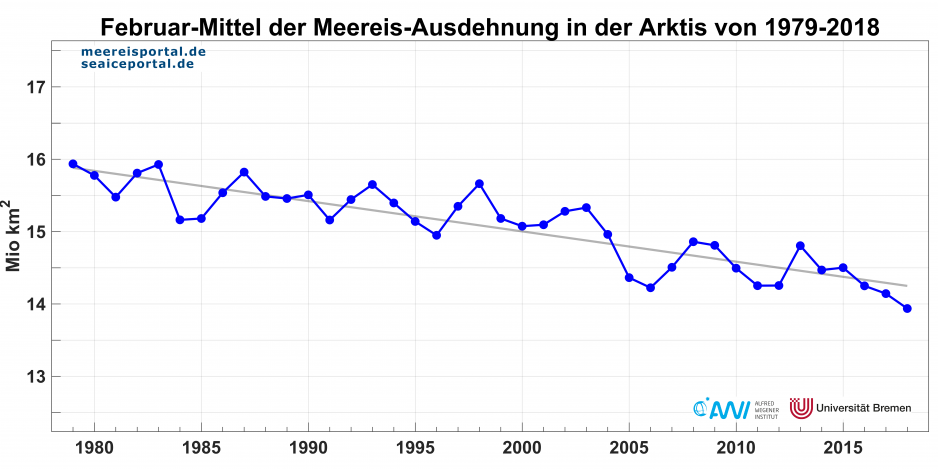February 2018 sea ice extent lowest ever recorded

"The February sea ice extent in 2018 has never been that low since measurements began", says Prof. Christian Haas, Head of the Sea Ice Physics section at the Alfred Wegener Institute in Bremerhaven as quoted on the sea ice information portal (Meereisportal). This has to do with very warm temperatures that have been penetrating the Arctic during February, which have resulted in temperatures reaching as high as 0 degrees.
"Temperatures in the Arctic are way beyond what they usually are, in the Central Arctic even higher than 10 degrees Celcius above normal", Prof. Haas emphasizes in the news release. The February temperature record in the Arctic was met in North Greenland on 25 February with +6 degrees, the experts from the Meereisportal report. At the same time, people in Berlin were shivering at temperatures around -10 degrees.
Extreme weather conditions in the Arctic; unprecedented sea ice season in Bering Sea
Extreme weather conditions in the second half of February caused the unusually high temperatures in the Arctic and the extremely low temperatures over Eurasia and North America. A driving factor is the air pressure system over the Arctic, which allowed warm air to flow northwards and to bring cold air down to mid-latitudes, the news release elaborates.
Consequently, the average ice extend in February plummeted to 13.95 km², a number never reached before since regular satellite measurements began in the late 1970s (see graph below). This is below the sea ice extends for February 2007 and 2012, the years when record summer sea ice minimums were recorded, experts warn.
The Bering Sea especially is reported to have seen a completely unprecedented ice season with 50% of ice in the region having disappeared during just two weeks. Also waters east of Greenland, east of Svalbard, and in the Barents Sea show especially low levels of sea ice, the Meereisportal reports.
Outlook to summer sea ice minimum
This year’s February sea ice extend is not the first record of very low winter ice maximums; March 2017 was the lowest in the satellite record for the month. Experts from the Meereisportal remark that such low ice extends in winter could precondition the ice situation in the Arctic in such a way that sea ice could diminish fast when the melting season starts in spring.
But the exact causal links between winter and summer sea ice are far from certain and weather and wind conditions during the summer are core factors for the course of the melting season, Prof. Haas elaborates in the news release.
The new normal?
Such incidents of warm air penetrating the Arctic during winter used to be very rare occasions. However, experts expect that these incidents will happen much more frequently in the future due to global warming and the receding sea ice. A recently published study (quoted in the Meereisportal’s news release) already shows hints into this direction: warm spells in the Arctic happened four times between 1980 and 2010; but they occurred in four of the last five years!

